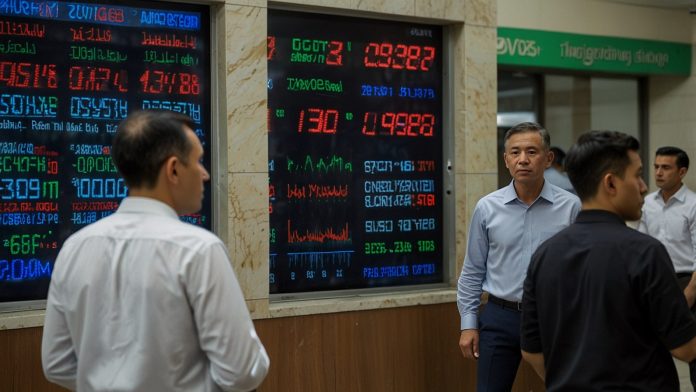The following events took place on August 27, 2025, which attracted the attention of the entire financial world: the exchange rate of the USD to UZS suddenly increased. The Central Bank of Uzbekistan (CBU) announced continued rise of US dollar to 12,354.65 UZS, 48.85 UZS more compared to the previous day, or 12,305.80 UZS.
This sudden rise has occurred following a short decline, likely due to a combination of external and internal factors that have impacted the Uzbekistani currency. The spike highlights the drawbacks of emerging markets, as they must contend with economic reforms in unstable global situations.
In 2025, the USD/UZS exchange rate continued to oscillate, with its average near 12,500 UZS in the first half of the year, but increasing in August due to seasonal imports and external uncertainties.
Global Dollar Rally Drives the Surge
One of the reasons that triggered the rise in the dollar against the UZS is the dominance of the US dollar in the international market. The dollar is gaining in 2025 due to the reluctance of the Federal Reserve to impose a rate reduction, which increases its attractiveness compared to other aggregate banks that adopt more liberal policies.
On August 27, the dollar index (DXY) increased by 0.141% to 98.3748, indicating that investors have strong faith in American assets. Dollar liquidity has been supported by President Trump’s actions, both in terms of his response to a US policy shift, impending tariffs and a request to lower Federal Reserve rates. This has caused pressure on the emerging market currencies such as the UZS, as has been observed by Reuters.
High world prices of gold, to which Uzbekistan is an export-rich country, tend to strengthen som. But troubles in the August mining production dampened export shipments, hurting foreign inflows and enabling the dollar to appreciate.
Uzbekistan’s Domestic Economic Pressures
In Uzbekistan, homegrown problems exacerbate the demand for the USD. The rising costs of importing energy and machinery are leading to the widening trade deficit, which has increased the demand for the dollar.
The CBU observed a -0.33% decline in the UZS earlier in the week, but the rebound has been attributed to market adjustments. The som has fallen by 37.5 per cent since the 2017 currency floatation with sharp movements due to fiscal discrepancies, according to TBC Capital.
A decline in remittances, a crucial source of support for Uzbekistan, has been observed, with a notable decrease in August. As key allies of America, such as Russia and Kazakhstan, stabilise their currencies, there is high demand for the dollar in the Tashkent market. Trading Economics forecasts that the USD/UZS contract may reach 12,335 by the end of 2014, which can be influenced by the following factors.
Impacts on Trade and Everyday Living
The complicating exchange rate affects the economy of Uzbekistan at large. The importers are paying more, increasing the likelihood of inflation to 10-12 per cent in 2025. Exporters are especially benefited by the stronger dollar, with cotton and gold being notable examples.
On the citizenry end, importation costs reflected in the higher cost of imported goods, both electronic and staple products, are the striking features that affect their budgets. A Tashkent trader said: The rise in the dollar hurts us in our expenses, but it is one of the larger movement trends in the marketplace.
The businesses have pressurised the CBU to intervene, yet the bank, due to its liberalisation interests, focuses more on market-determined rates. Although this will lead to long-term stability, it exposes the system to short-term shocks.
Expert Outlook and Long-Term Trends
Researchers give mixed forecasts. Traders Union has also pegged the USD/UZS at 15,562 by 2030, but an improved quantity of gold exports may curb its short-term ascent. Kun.uz predicts that the rate will be 14,150 UZS by 2027, thanks to economic growth stabilisers. The J.P. Morgan estimates that the USD could be weak in 2025 due to the US deficits, but tariffs can still propel surges.
The future of Uzbekistan depends on the reinforcement of its foreign reserves through the sale of gold and the diversification of its economy. Its 27 August surge represents its increasing part of world markets, but also the (external) volatility. In the wake of 2025, market participants will closely watch US policies and local developments to gain insight into the path of the USD/UZS.



 Bitcoin
Bitcoin  Ethereum
Ethereum  Tether
Tether  XRP
XRP  USDC
USDC  TRON
TRON  Lido Staked Ether
Lido Staked Ether  Cardano
Cardano  Avalanche
Avalanche  Toncoin
Toncoin  Wrapped SOL
Wrapped SOL